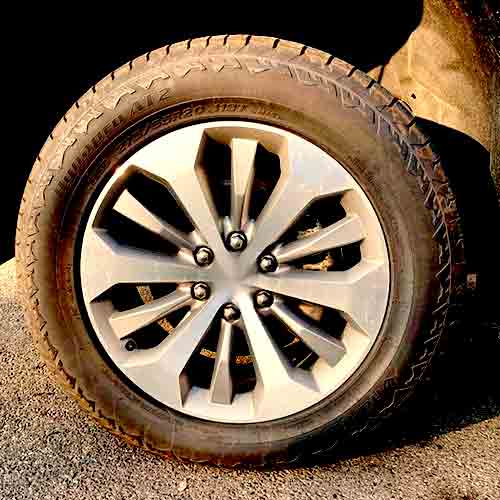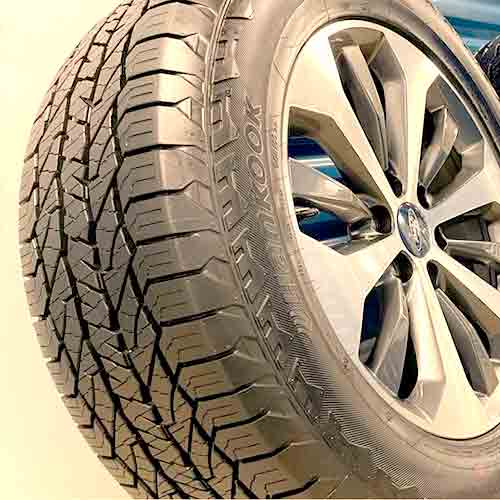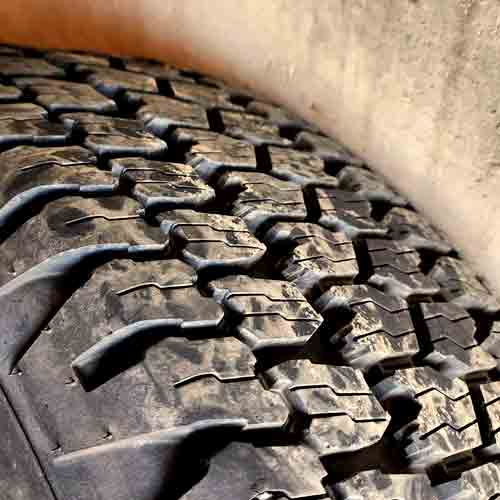The tire market is constantly evolving, and both the Hankook Dynapro AT2 and the Goodyear Wrangler ATS are at the forefront of the all-terrain category, especially when it comes to on-road oriented ones. They offer a great balance between traction and comfort, but still, which one is the better choice for you? Let’s find out.

Being a tire engineer, from my perspective, the Hankook Dynapro AT2 features superior dry grip in terms of handling and steering and offer better tread life, noise reduction and winter performance. While the Goodyear Wrangler ATS comes out on top in wet grip and hydroplaning department, and offers better fuel economy and overall comfort. Off-road both tire are similar and not so great on aggressive terrains.
Tire Facts
Starting with Hankook Dynapro AT2, this tire has following specs.
- Sizes: 15 to 22 inches
- Speed rating: S and T.
- Load Rating: SL to F.
- Weight: 29 to 80 lbs
- Tread depth: 12 to 16.4/32″
- Warranty: 60k miles on all sizes is given.
On the other hand, the Goodyear Wrangler A/TS comes in 15 to 20 inches with following specs:
- Speed ratings: R and S.
- Load ratings: SL, C, D and E.
- Weight range: 30 to 60 lbs.
- Tread depth: 13 to 16/32″.
- Ratings: No 3PMSFR.
- Warranty: None.
Tread Features
The Hankook Dynapro AT2 tire features a 5-rib design. Let’s start with the sides of the tread.

The shoulder lugs of the tire, although extend slightly towards the sidewalls and make some lugs there, they are not thick enough, and their edges are not staggered.
These may compromise things a little off-road, but on pavements, there are no complaints, as the tire is pretty stable when it comes to handling, as all shoulder lugs have reinforced foundational supports.
Moving towards the middle of the tire, there are 3 longitudinal ribs there, with the middle most having lugs pasted on a secondary running rubber layer, providing decent directional grip.
This rib is actually multi-functional providing off-road traction as well, as the biters there in the form of notches facing sideways and the stepped edges grip form all directions (and stepped edges act as stone ejectors).
The surrounding ribs although lack these (discussed) biters, they do carry similar full depth sipes, allowing lugs to open all the way and provide chewing off-road.
On the other side, you get a similar looking longitudinal structure with Goodyear Wrangler A/TS.

Starting with it’s outer edges, the tire like its counterpart, also does not feature staggered shoulders and is missing with sidewall lugs.
And on the inner sides (of these shoulders) they are attached with another set of blocks, together forming multiple notches, offset edges and rectilinear sipes.
Moreover, these lugs also make wider outer circumferential grooves separating the two ribs in the middle.
And where these blocks renders off-road grip, the two closed up ribs in the middle ensure the tread makes ample contact with the roads as well, yielding smooth pavement traction at the same time.
Also all these lugs carry a ton of sipes, these are although not that interlocking, they get to be full depth, still, providing a good efficacy in wet traction.
Fuel Efficiency
Fuel consumption is largely influenced by the rolling resistance of the tires, with the tread structure and weight being significant factors. Although off-road tire designs may not perform optimally in fuel efficiency, even a tiny bit of a difference matters a lot in the long run.
That’s why even with a difference of just 0.35 MPG, the Hankook Dynapro AT2, taking the lead, shows up with superior fuel economy (my testing shows).
And although it may seem counterintuitive, considering the tire’s greater weight, it makes perfect sense why you analyses its structure and tread composition.
It’s harder compound and more packed up lugs arrangement basically account for less amount of flexing on the lugs, so less energy gets wasted into that, and is rather spent in to the rolling of the tire.
Goodyear Wrangler ATS on the other side, with its softer compound does the opposite. And with a slightly more spacious structure, it’s lighter weight empathizes more pressure on it’s lugs, still.
Highway Capability
When examining the dry performance of these boys, I considered how well they do in the handling, gripping and steering department.
Let me discuss each of these elements with more detail.
Directional Traction
The overall grip, a tire generates, depends on the tread’s contact patch availability with the ground.
Hankook Dynapro AT2 shows up with shorter braking distances, with it’s consistent running central section.
(Braking distance is the direct measurement of directional traction).
Whereas, the Goodyear Wrangler ATS on the other hand, does not feature a better contact with the ground, as it’s central most area consist of grooves instead of continuous running rib seen on Dynapro.
Dry Cornering
As weight shifts towards the shoulders during turns, it emphasizes the direct relationship between the outer ribs (of the tread) and the ground.
That’s why Hankook Dynapro AT2 with a more stable structure provides better efficacy. It’s lugs have secondary rubber layers underneath (consisting of a stiffer compound), and its tread is already harder to begin with.
This accounts for a more stable connection with the ground, where lugs aren’t susceptible to bending too much as the tire corners, yielding superior steering response and with it handling.
Goodyear Wrangler ATS on the other although puts less pressure on it’s lugs with it’s lighter structure, it’s softer compound, and irregular block geometry gets to loose in provide fast enough steering feedback.
Wet Grip
For improved grip and stability on wet roads, tires must incorporate both ample biting edges and tread voids. Both of these dimensions account for faster water removal form the tread.
Out of both boys here, the Hankook Dynapro AT2 is lacking overall. The tire features a less spacious structure in comparison, so it’s less resistance to hydroplaning. And since it’s tread composition is stiffer, it’s does not allow its sipes to effectively bend/contact/expand, and suck water particles in (this is how they work), limiting grip.
Goodyear Wrangler ATS on the other side offers a better combination of lateral and longitudinal channels all over the tread.
Moreover, the tire also features a lot more siping, which also have the needed flexibility in them, thanks to it’s supple tread compound, allowing for effective water clearing on a micro level, while the rest of it moves out through the help of grooves.
Durability
Durability is a critical consideration for off-road tires, given the demanding nature of sharp, puncturing conditions. To address this requirement, they are given with powerful internal and outer construction.
Both of these tires although feature a tough enough cut resistant tread rubber, internally , the Hankook Dynapro AT2 gets to be more durable with it’s 3 ply polyester carcass.
The Goodyear Wrangler A/TS on the other side although features 2 steel belts and nylon cap plies like its counterpart, it’s casing (protecting the sidewalls), only get to be 2 ply.
So the tire is weaker form sides, (which need the most protection).
Off Road Traction
Different terrains require various sets of skills from off-road tires, that’s why I decided to divide this section in to the following.
On Mud
The success of all-terrain tires in mud depends on their ability to self-clean their tread voids. That’s why with a slightly more voided structure, the Goodyear Wrangler ATS yields better traction capabilities.
The tire comes with wider outer longitudinal grooves, and lateral shoulder voids. Moreover, although it features longitudinally arranged ribs, the lugs are not place on a continuous running (secondary) layers, like seen on it’s competitor.
So the tire offers faster mud evacuation and does not resist mud while leaving out laterally.
On Rocks
On rocks, tires must have strong and sturdy sidewalls to counteract sharp obstacles and punctures. Moreover, you also need a lot of biting edges combined with a flexible compound so tread blocks can easily chew on the surface.
Considering both these factors, I have rate Hankook Dynapro AT2 better.
The tire features superior durability, with it’s 3 ply sidewalls, and features a lot more biters, in the form of in groove notches, sharp edges, and a lot of off-sets.
Goodyear Wrangler ATS on the other side is not as durable, nor offers as many biters, yet its softer compound still offers decent traction, allowing its full depth sipes to easily split open and chew on rocks.
Also Read –
Are A/T tires good on rocks: https://tiredriver.com/are-all-terrain-tires-good-for-rocky-terrains/
On Sand
Sand requires floating tires. And although all-terrain tires “typically” have sidewall lugs which spread out by lowering the air pressure, both of these don’t have them.
Yet, still the Wrangler A/TS offers better results with it’s lighter structure, smoother outer edges, and softer overall tread composition.
All these features ensures better prevent this tire from digging.
In comparison, the Dynapro AT2 is harder to maneuver, especially on steep climbs. And why won’t that be, its 3 ply sidewalls brings it’s weight close to what you generally see on mud-terrain tires. So on wonder the tire is more susceptible to digging here.
TreadWear
As mentioned above, (in the fuel section), the Dynapro AT2 even with it’s larger weight still puts less pressure on it’s lugs, they get to rub off the surface with smaller amounts of frictional forces.
So they get don’t show up with faster wearing rate.
This is further aided by the tire’s stiffer rubber composition, unlike the Wrangler ATS.
On-Road Comfort
The two primary elements that determine the comfort of a ride are the tire tread noise and the tire’s capability to reduce road imperfections through its structure and tread design. I’ll examine each of these factors in further detail.
Road Noise
Noise is a very critical subject, as it depends on a lot of factors, which include, surface tension, air flow permissibility, and overall tread structure.
And considering all, it can be explained why the Hankook Dynapro AT2 shows up quieter, off the two.
First off, the tire offers a more crowded up lugs arrangement, and so they don’t allow air particles to come in and hit around (which produces noise).
Moreover, it’s stiffer rubber compound, is also less susceptible in generating in-groove resonance (which is a technical name for echoing of the sound waves).
In comparison, the Goodyear Wrangler ATS with it’s open tread voids, especially towards outer edges account for greater air particles to flow in/out of the tread, having a greater impact.
On-Road Stability
When the tread meets up with the road, it deforms a little bit, and with it, the energy from the bumps gets settled in, before reaching the drivers seat.
That’s why out of both tires, the Wrangler ATS, with supple tread composition and less no. of plies in it’s internal construction offers superior efficacy.
Whereas the Hankook Dynapro AT2 with it’s less-spongy rubber and a more rigid internal construction, consisting of 3 ply polyester offers a bumpier ride in comparison.
Snow Performance
Out of both tires, the Hankook AT2 still gets to have an upper hand considering all types of terrains (including ice).
This tire basically features a lot more biters, in the from of in-groove notches, off-set edges and full depth siping. And these offer superior snow grabbing capabilities, making superior contact on the ground with the lodged snow.
(This yields better results compared to rubber to snow contact).
On the other side, the Wrangler A/TS although features a better thermal adaptability with it’s rubber, (it’s less prone to getting rigid with freezing temperatures), the tire with it’s lacking overall biting edges, can’t offer similar gripping values.
That’s why its not branded with 3 peak mountain snowflake rating unlike its competitor.
Take Home Points
Out of both tires, the Dynapro AT2 although offers amazing dry grip, it’s wet traction can use some help. Though it’s better in other performance areas as well (on highways), including tread wear, on-road noise, and winter performance.
On the other side, the Wrangler ATS does better on wet roads, and gives out desirable fuel economy and overall on-road comfort.
The tire also does great on mild off-road terrains, but lacks in providing as much durability as the Hankook AT2.